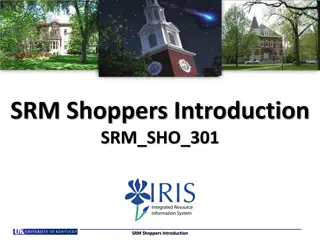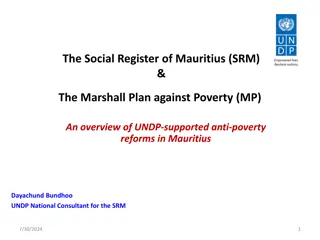
Quality of Life Among Leprosy Affected Persons in Rural Tamil Nadu
Explore the impact of leprosy on quality of life in a rural setting in Tamil Nadu, India. Discuss the prevalence, challenges, and strategies to improve post-treatment care for individuals affected by leprosy, emphasizing the importance of managing disabilities to enhance overall well-being.
Download Presentation

Please find below an Image/Link to download the presentation.
The content on the website is provided AS IS for your information and personal use only. It may not be sold, licensed, or shared on other websites without obtaining consent from the author. If you encounter any issues during the download, it is possible that the publisher has removed the file from their server.
You are allowed to download the files provided on this website for personal or commercial use, subject to the condition that they are used lawfully. All files are the property of their respective owners.
The content on the website is provided AS IS for your information and personal use only. It may not be sold, licensed, or shared on other websites without obtaining consent from the author.
E N D
Presentation Transcript
Quality of life among leprosy affected persons-A cross sectional study in a rural block, Tamil Nadu, India Title of Paper Presenting Author Dr. G. Dinesh Kumar M.D Designation Assistant Professor, Dept. of. Community Medicine, SRM MCH & RC, SRM UNIVERSITY, CHENNAI,INDIA Dr. K.R John , Dr. M. Logaraj Co- authors Date 16.05.2016 Venue Hotel Hilton San Antonio Airport, San Antonio, Texas, USA
CONTENTS INTRODUCTION OBJECTIVES MATERIALS & METHODS RESULTS DISCUSSION CONCLUSION RECOMMENDATIONS REFERENCES
INTRODUCTION Leprosy is a chronic granulomatous infection, principally affecting the skin and peripheral Mycobacterium leprae(1) remains peripheral neuropathy and disability in the world, despite extensive efforts to reduce the disease burden (2). nerves, leading caused cause by of a Impairments may give rise to disabilities, such as limitations of activities involving the use of hands, feet and eyes, and restrictions in social participation.
CURRENT SCENARIO According to official reports received from 121 countries from all WHO regions except for Europe, the global registered prevalence of leprosy at the end of 2014 was 174 554 cases (0.24 cases per 10 000 people). The number of new cases reported globally in 2014 was 213 899 (0.3 new cases per 10 000 people).
INTRODUCTION India achieved the goal of elimination (i.e point prevalence rate of less than 1case leprosy as a public health problem at National level in Dec 2005 (3) per 10,000 population) of Care after cure is an important aspect and which needs more concentration as most of the patients situation worsen after being released from treatment. (3).
INTRODUCTION WHO defines Quality of Life as Individual s perception of their position in life in the context of the culture and value systems in which they live and in relation to their goals, expectations, standards and concerns . It is a broad ranging concept affected in a complex way by the person's physical health, psychological state, level of independence, social relationships, personal beliefs and their relationship to salient features of their environment
INTRODUCTION There should be a clear focus on managing disability, especially after treatment completion, as it can have a huge influence on quality of life of the people Global Leprosy Strategy 2016 2020 , which is structured around the following 3 core pillars: Pillar I: Strengthen government ownership, coordination and partnership Pillar II: Stop leprosy and its complications. Pillar III: Stop discrimination and promote inclusion
OBJECTIVES To determine the Quality of Life (QoL) among leprosy affected persons ( LAP) using the WHOQOL-BREF To find out the factors associated with Quality of Life (QoL) among leprosy affected persons ( LAP)
MATERIALS & METHODS STUDY DESIGN Cross sectional study STUDY AREA Leprosy settlements in Kattankulathur block Bharathapuram, Alapakkam Solomon Nagar, Alapakkam Calvary Nagar, Vallam Bethel Nagar, Alapakkam Annai Indra Memorial Nagar,Chettipuniyam Gnanodaya trust,Vengadapuram
MATERIALS & METHODS STUDY POPULATION Inclusion criteria; Treatment completed persons Exclusion criteria; Age less than 18 Not willing to participate in the study
MATERIALS & METHODS SAMPLE SIZE -247 n = (1.96)2Pq / d2, and on the basis using the formula of deformities prevalence as 20 % from a study in South India6 SAMPLING TECHNIQUE - SIMPLE RANDOM SAMPLING STUDY PERIOD September 2013 August 2014
FLOWCHART DEPICTING SAMPLING PROCEDURE KATTANKULATHUR BLOCK Total number of leprosy settlements 9 Total number of leprosy affected persons (LAP) in these Settlements = 528 Permission not obtained from 2 Total number of Leprosy settlements obtained permission = 7 Total number of leprosy affected persons (LAP) in 7 Settlements = 340 Excluded from the study = 93 Reasons for exclusion: Aged below 18. Cognitive defect. Not willing to participate in the study. Very sick persons. Final study participants (n) = 247
DATA COLLECTION After getting clearance from the Institutional Ethical Committee A pilot study was conducted. For the each of the villages, a visit was done to the meet with the local leaders, they were explained the details of the study. After getting permission, House to house interview was conducted using a predesigned, pretested questionnaire
DATA COLLECTION Questionnaire elicited information on socio demographic variables and information on leprosy like type of leprosy, duration since diagnosis etc Subjects were also graded for any deformities in the body using the WHO disability grading. Informed Consent was also obtained for the same. Female subjects were examined in the presence of female members
GRADING HANDS AND FEET Grade 0 No Anaesthesia, no visible deformity or damage Grade 1 Anaesthesia present, but no visible deformity or damage Grade 2 Visible deformity or damage present W.H.O DISABILITY GRADING SCALE GRADING EYES Grade 0 No eye problem due to leprosy; no evidence of visual loss Grade 1 Eye problems due to leprosy present, but vision not severely affected as a result can count fingers from 6 metres) Grade 2 Severe visual impairment (vision worse than 6/60; inability to count fingers from 6 metres); also includes lagophthalmos, iridocyclitis and corneal opacities
Quality of life (QOL) information was collected using the instrument WHOQOL-BREF. This questionnaire composes of 26 questions, two general questions and the remaining 24 encompass four domains: physical, psychological, social relations and environment. The sum of the responses provides a score for the overall QOL8. Higher score indicates a better quality of life
ANALYSIS Data was entered in MS-Excel sheet spread sheet.(2007) . Data was analyzed using statistical package for social sciences version 20 (trial version). Univariate analysis of the variables was done followed by unpaired t test for comparison of means Linear regression analysis was done with overall Quality of life as the dependent variable and baseline variables as the independent variables. p value of less than 0.05 was considered to be statistically significant
TABLE 1 : SOCIO-DEMOGRAPHIC DISTRIBUTION OF STUDY PARTICIPANTS Socio-Demographic variables Sex Education N 142 105 135 62 34 16 110 38 78 1 20 209 38 30 45 78 94 171 76 % 57.5 42.5 55 25 14 6 44.5 15.4 31.6 0.4 8.1 84.6 15.4 12.1 18.2 31.6 38.1 69.2 30.8 Male Female Illiterate Primary Secondary HSC Married Unmarried Widow Divorced Separated Paucibacillary Multibacilary <15 yrs 15 -29 yrs 30-44 yrs 45 yrs & above No Yes Marital status Mean Age 60.19 12.8 Mean income 19 USD Type of Leprosy At Diagnosis Duration since disease diagnosis Surgeries experienced due to leprosy Deformities Present Absent 222 25 89.9 10.1
Fig 1: W.H.O Disability grading of Study Participants Grade2 217(87.9%) Grade1 5(2%) Grade 0 25(10.1%) 0 50 100 150 200 250
Fig 2: QoL scores based on the different domains QUALITY OF LIFE SCORES - DOMAINS 69.21 Mean QOL scores 20.55 24.34 16.16 8.16 Physical Psychological Social relationship Environment Overall QOL QUALITY OF LIFE DOMAINS
TABLE 2: COMPARISON OF BASELINE VARIABLES WITH OVERALL QoL SCORES Quality of life domains Overall QOL Mean Socio demographic variables N SD p value 0.021* 0.343 0.001* <0.001* 0.005* 0.021* 0.121 <60 >60 Male Female Literate Illiterate Employed Unemployed Married Unmarried <19 USD >19 USD Nuclear Others 131 116 142 105 112 135 32 215 110 137 169 78 206 41 70.58 67.66 69.73 68.50 71.48 67.32 80.31 67.55 71.20 67.61 68.21 71.36 69.65 67.00 10.575 9.069 9.636 10.443 9.702 9.855 8.778 9.069 10.380 9.390 9.494 10.721 10.205 8.562 Age Sex Education Occupation Marital Status Income Type of Family Type of leprosy Paucibacillary Multibacillary <40 years >40 years Present Absent Yes No Yes No 209 38 142 105 222 25 86 161 76 171 69.56 67.24 70.80 67.06 68.16 78.48 70.55 68.49 67.72 69.87 10.266 8.099 10.308 9.145 9.377 10.599 10.360 9.735 9.162 10.286 0.187 0.003* <0.001* 0.123 0.120 Disease duration Deformities Family history Surgical History * - Statistically significant
TABLE 3 : LINEAR REGRESSION ANALYSIS Unstandardized Coefficients Standardiz ed Coefficients 95.0% Confidence Interval for B Variable t p Value B Std. Error 1.255 1.144 1.349 1.920 1.146 Beta Lower Upper Age .131 1.972 -1.723 -11.225 -3.147 .007 .099 -.080 -.378 -.157 .104 1.724 -1.277 -5.847 -2.746 0.917 0.086 0.203 <0.001* 0.006* -2.34 -0.28 -4.38 -15.0 -5.40 2.60 4.22 0.93 -7.44 -0.89 Education Income Occupation Marital status Disease duration Deformities -1.337 1.259 -.066 -1.062 0.289 -3.81 1.14 6.848 1.891 .207 3.621 <0.001* 3.12 10.57
DISCUSSION Among the 247 subjects in our study, mean domain scores for the various domains were; Physical (20.55 3.9), Psychological domain (16.16 2.9), Social relationship domain (8.16 2.08) and Environment domain (24.34 3.9). On Comparison with other studies, our study had better scores in the all the domains except the social relationship domain.9, 10 In spite of the high prevalence of deformities, the physical domain score in our study was found to be high
DISCUSSION Lower age groups had a better quality of life scores across all the domains. Males had a better score compared to females in all the domains of QOL. But there was no statistical significance seen in any of the domains. The type of leprosy (i.e. paucibacillary or multibacillary) at the time of diagnosis did not have any significance on any domains of the quality of life
DISCUSSION On assessing the overall quality of life it was found that age, education income, occupation, marital status, disease duration and the disability had influence on the quality of life. Linear regression model after controlling the effects of other variables showed that occupation, marital status and disability had significant effect on the overall quality of life.
LIMITATIONS Cross sectional study True temporal relationship cannot be established. Covered a very selective area due to resource constraints and hence limits the generalisability of the results WHO disability grading system that does not account for any disability or deformity of the face
RECOMMENDATIONS More studies to assess those being released from treatment. CARE AFTER CURE SHOULD NOT BE NEGLECTED The road to life of the affected does not end with cure of the disease, but continues way forward till they attain the best of their abilities
REFERENCES [1] Britton WJ, Lockwood DN. Leprosy. Lancet 2004 Apr 10; 363(9416):1209-19 [2].Madhavan K, Vijayakumaran P, Ramachandran.L, Manickam C, Rajmohan R, Mathew J et al. Sustainable leprosy related disability care within integrated general health services: findings from Salem District, India. Lepr Rev.2007; 78:353 361. [3].VanBrakel WH, Sihombing B, Djarir H, Beise K, Kusumawardhani L, Yulihane R et al. Disability in people affected by leprosy: the role of impairment, activity, social participation, stigma and discrimination. Global Health Action. 2012; 5 [4].Sarkar J, Dasgupta A, Dutt D. Disability among new leprosy patients, an issue of concern: An institution based study in an endemic district for leprosy in the state of West Bengal, India Indian J Dermatol Venereol Leprol 2012; 78:328- 34. [5].Jain P, Tripathi D, Singh CM, Srivastava DK, Sharma A , Bansal M.A study of high disability rate among leprosy affected persons in Gwalior district .Indian Journal Of Community Health.2011; 23(2): 90-92. [6].Chavan LB, Patel P. Epidemiology of disability in incident leprosy patients at supervisory urban leprosy unit of Nagpur city. Natl J Community Med 2011; 2(1):119-122. [7].Brandsma JW, VanBrakel WH. WHO disability grading: operational definitions. Lepr Rev 2003; 74: 366-373. [8].Rad F, Ghaderi E , Moradi G , Salimzadeh H. The Study Of Disability Status Of Live Leprosy Patients In Kurdistan Province Of Iran. Pak J Med Sci 2007 Oct-Dec; 23(6):857-61 [9].Nardi SM, Paschoal Vdel A. Chiaravalloti-Neto F, Zanetta DM. Leprosy-related disabilities after release from multidrug treatment: prevalence and spatial distribution. Rev. Sa de P blica 2012 Dec; 46(6):969-977. [10].Ishida Y. Prevalence of disability among leprosy patients and effectiveness of leprosy reaction services with standard prednisolone treatment at field level in an endemic country--some data from joint leprosy research collaboration in Myanmar. Nihon Hansenbyo Gakkai Zasshi.2009 Sep; 78(3):277-82
REFERENCES [11].Gautham HYPERLINK "http://www.ncbi.nlm.nih.gov/pubmed?term=Gautham MS[Author]&cauthor=true&cauthor_uid=22125937"MS, Dayananda M, Gopinath D, Shivraj NS, Riyaz B, Pruthvish S.Community-based needs assessment of Leprosy patients in Chamrajanagar District, Karnataka, India. Lepr Rev 2011Sep; 82(3): 286 295 [12].Raposo MT, Caminha AV, Heukelbach J, S nchez-Gonz lez M , de Medeiros JL, Nemes MI. Assessment of physical impairments in leprosy patients: a comparison between the world health organization (who) disability grade and the Eye-Hand-Foot score. Rev Inst Med Trop Sao Paulo. 2011 Mar-Apr; 53(2):77-81 [13].Kumar AA, Naidu AA, Mahapatra BR, Porichha D. Trend in decline in leprosy disabilities of a LEPRA project in Malkangiri district, Odisha, India. Indian J Lepr.2013 Jul-Sep;85(3):101-8. [14].Shen J, Liu M, Zhou M. Current situation of leprosy colonies/leprosaria and their future in P.R. China. Lepr Rev 2007 Sep; 78(3): 281 89 [15].De Araujo E Araujo AE, De Aquino DM, Goulart IM, Pereira SR, Figueiredo IA, Serra HO et al. Factors associated with neural alterations and physical disabilities in patients with leprosy in S o Luis, State of Maranh o, Brazil. Rev Soc Bras Med Trop 2014 Jul; 47(4):490-7 [16].Guerrero MI, Muvdi S, Leon CI. Delay in leprosy diagnosis as a predictor of disability in a cohort of patients in Colombia, 2000 - 2010. Rev Panam Salud P blica. 2013 Feb; 33(2):137-143. [17].El-Dawela RE, Mohamed AS, Yousef F Analysis of newly detected leprosy in Sohag Governorate, Upper Egypt, 2004-2008.Lepr Rev.2012 Mar; 83(1):71-9. [18].SinghL, Malhotra R, Bundela RK, Garg P, Dhillon KS, Chawla S, Lal BB. Ocular disability--WHO grade 2 in persons affected with leprosy. Indian J Lepr. 2014 Jan-Mar; 86(1):1-6. [19].Waziri-Erameh MJ, Omoti AE. Ocular leprosy in Nigeria: a survey of an Eku leprosorium. Trop Doct. 2006 Jan; 36(1):27-8.






















